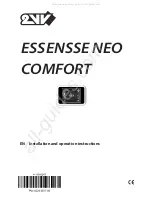
101
31-00083—02
Induction VAV Boxes
Induction VAV boxes use induced return air as the reheat
medium which means no parallel fan is present in the VAV
box. Induction VAV boxes are usually installed above the
ceiling and draw return air from the plenum created by a false
ceiling. The VAV box controller uses an air flow sensor for
controlling air flow and a room sensor for controlling room
temperature similar to pressure independent VAV boxes. The
volume of air coming through the primary damper is controlled
by positioning both dampers simultaneously so that as the
primary air damper closes, the return air damper opens.
Return air is thus drawn into the unit and recirculated into the
space. Like pressure independent VAV boxes the controller
resets the air flow setpoint of the controller as the thermal load
changes in the conditioned space. For extremely cold design
conditions, a reheat coil can be added. The induction VAV
ATU maintains satisfactory air motion at lower loads than a
throttling VAV box can, however, the wide use of Parallel Fan
Powered VAV boxes has now limited the use of Induction VAV
boxes.
Single-Duct Constant Volume Zone Reheat
Air Terminal Units
Single-Duct Constant Volume Zone Reheat Systems are used
in low static pressure systems and have a heating coil (hot
water, steam, or electric) in the branch supply duct to each
zone. The central air-handling unit supplies constant
temperature air and a manual balancing damper in each zone
is set in a fixed position to determine the amount of air
delivered to that zone. The volume of air delivered to each
zone will change as the static pressure of the supply duct
changes, however, in low static pressure systems the changes
in the supply duct static pressure are small and do not have a
dramatic effect on the amount air delivered to the zone. The
control strategy used in single zone reheat systems is simple
and involves activating electric heat or positioning a valve in
conjunction to the zone temperature. In most cases this is
accomplished using a simple space thermostat. However,
direct digital controllers can be used in these cases to control
multiple zone valve positions the reheat coil valve (or electric
heating elements) as required to maintain space condition.
TEMPERATURE AND VENTILATION CONTROL
A single space controller or thermostat controls the heating
coil, ventilation dampers, and cooling coil in sequence as
thermal load varies in the conditioned space. On rooftop
mounted units the heating coils are typically electric and the
cooling is by a self contained air-conditioning system using
direct expansion cooling coils. However, single zone air
handling systems that are located in a mechanical room of a
building often employ hot water (hydronic) heating coils and
use chilled water coils for cooling. The ventilation dampers
(Outdoor air, Return air, and Exhaust air) are controlled to use
outdoor air for the first-stage cooling when the conditions are
appropriate. When outdoor air temperature or heat content
(enthalpy) rises to the point that it can no longer be used for
cooling, an outdoor air limit control overrides the signal to the
ventilation dampers and moves them to the minimum
ventilation position, as determined by the minimum positioning
switch or the minimum position setpoint in the controller.
Indoor air quality control is also accomplished with the Single
Zone controller using sensors and control strategies that
increase the minimum position of the outdoor air damper to
allow more fresh air into the building when the indoor air
quality is poor. A zero energy band often separates the
heating and cooling control ranges, thus saving energy.




































